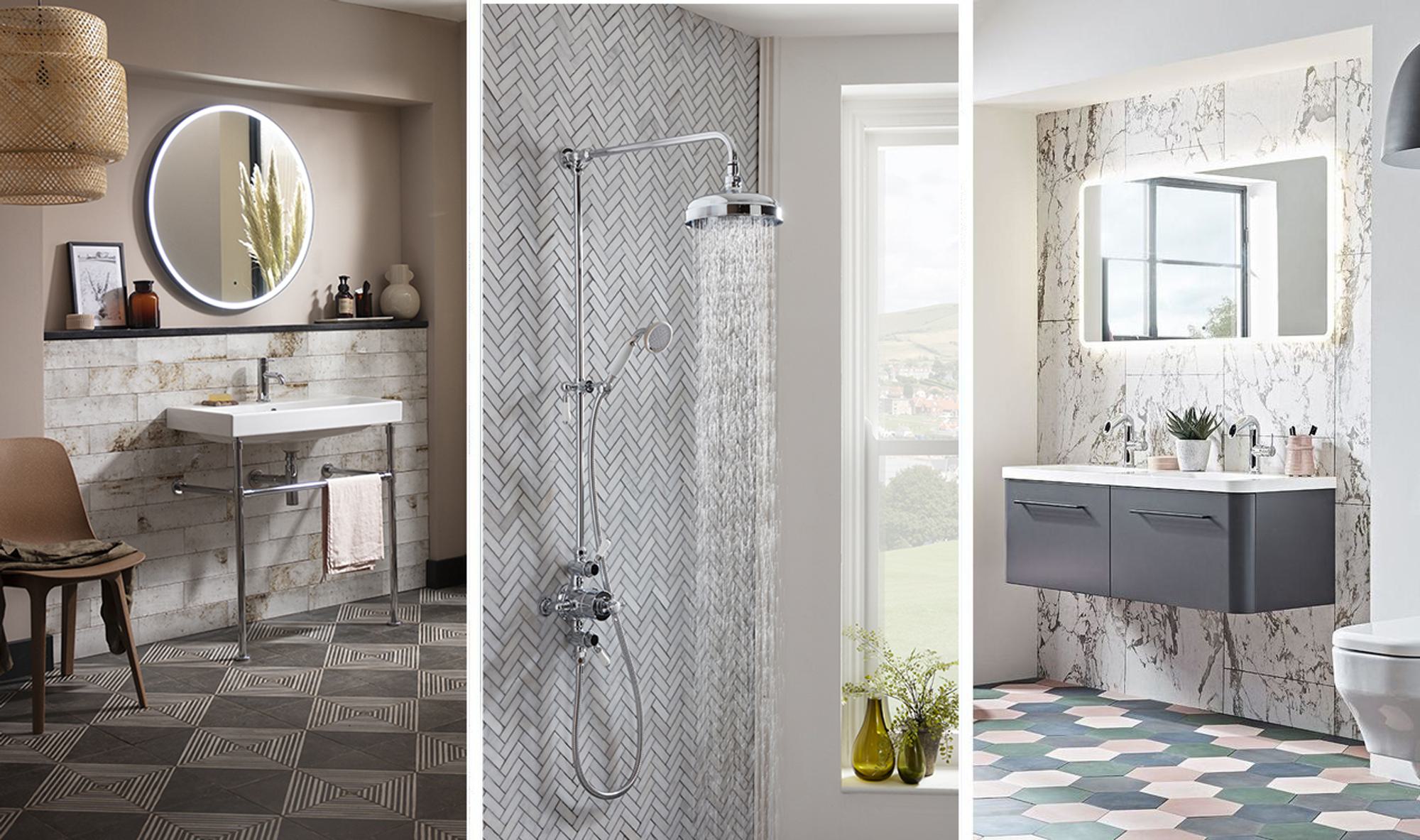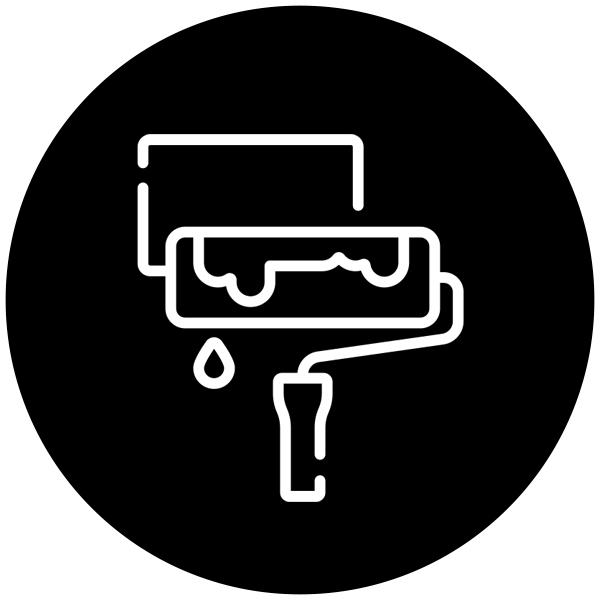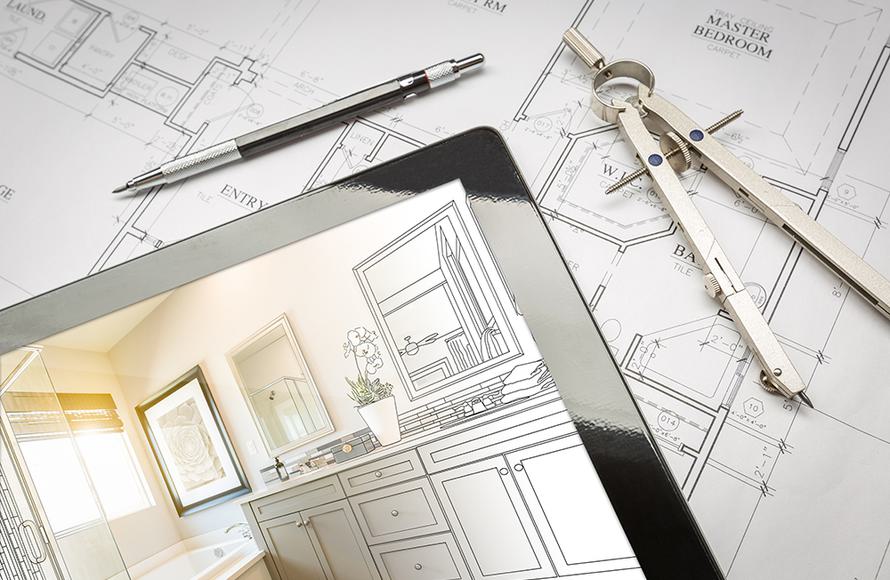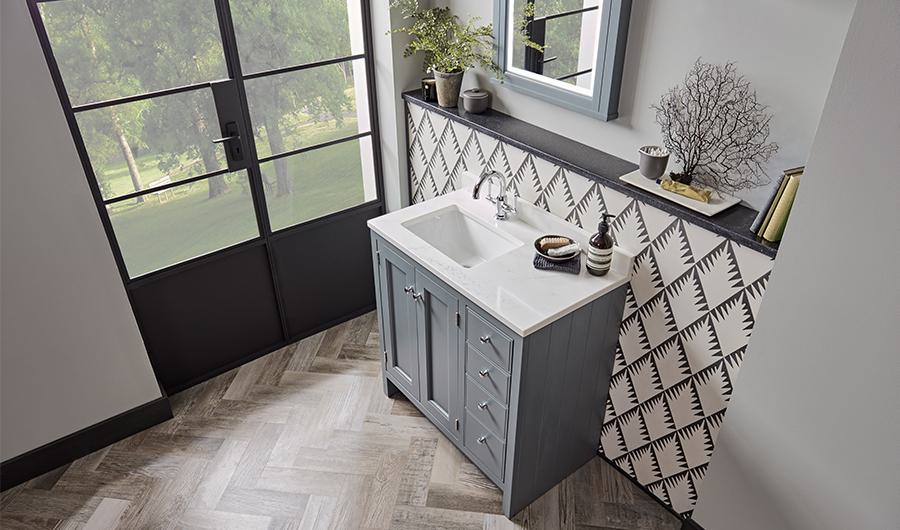Bathroom Buying Guide - Designing your Bathroom
Our comprehensive guide to designing your bathroom.
Now that the planning phase of your bathroom renovation is complete, the design phase allows you a little more scope to be creative in realising your dream bathroom space. From layout to style to surfaces, we walk you through every element of your bathroom design.
Bathroom Size & Layout
A few practical elements to take into account.
The function of the bathroom, the size of your bathroom, the layout and the shape will all dictate the direction your bathroom design will take and the look of the finished project.
Function
In the bathroom, as a rule, form follows function, and the practical requirements of the bathroom should take precedence over more ‘ornamental’ design considerations. Important questions to ask yourself now include how many people will the bathroom accommodate, will this be a family bathroom and even how can your new bathroom add value to your home? For instance, while a walk-in shower may be appealing now, having at least one bathtub in your home is often a requirement for young families and could impact the sale of the house at a later stage.
Size & Shape
So often the ‘forgotten room’ in the house, more often than not, the bathroom is that room that is built into the space leftover, and this room may be l-shaped, rectangular or long and narrow, all of which must be taken into consideration when thinking about your design. Smaller bathrooms will benefit from fixtures that suit the scale of the room, while it is worth considering using the full space that a bigger bathroom affords. For instance, rather than keep your units against each wall, why not divide your room into functional zones, and maybe even use the centre of the room to showcase a freestanding bath?
Window & Door Location
Take into consideration where your doors and windows are located in your bathroom, as these will often dictate where you place your fixtures. We recommend a clear space of 32inches to allow the door to swing to it’s full width. To save on valuable space in small bathrooms, consider installing a barn or sliding door or a door that opens outwards. Try if you can to tuck your WC fixtures away from the full view of an open door for privacy! Finally, natural light and ventilation is important to keep your bathroom from getting damp, so consider window placement when designing your layout.
Plumbing Location
Depending on your budget, plumbing location is the factor that is likely to most determine the design of your bathroom. Do you want to simply swap out existing fixtures, saving on plumbing costs or if your budget stretches to it you can reconsider the existing plumbing layout and really get creative! As a rule, it’s generally cheaper to keep plumbing to a single wall. Why not get some single-wall layout ideas from our downloadable layout examples?
Bathroom Colour Palettes
Layer on colour to enhance a bathroom style.
Once you have settled on a bathroom style, it's important to consider your paint and colour choices to help bring the look together cohesively. Again, would-be bathroom designers are often overwhelmed by choice when it comes to colour- follow and employ our simple tips to help you find your ideal bathroom colour scheme.
Use a Colour Wheel
The colour wheel is widely used by interior designers and decorators, and is a visual representation of colours and their relationships to one another. The most common version of this wheel contains three primary colours and nine of their derivatives. Without becoming an expert, one of the safest and easiest colour wheel schemes is called 'Monochromatic' which is essentially selecting one colour and using different shades and tints of this single colour. Another simple scheme is called 'Complementary' and consists of selecting any two colours that are located opposite to each other on the colour wheel.
Borrow Colour
Unsure where to start? Borrow a colour scheme from elsewhere in your home. Take a walk around your home with a pen and paper and spend time in each room writing down the colours you have used and the ones you like the best. Using the same colour in different rooms will create consistency and rhythm and bring the styling of the house together.
Rule of Three
This simple rule states that around 60% of a room should be dominated by a primary colour, usually one that is light or neutral. This primary colour should be used on walls or other large surface areas. Next, 30% of the room is dedicated to a secondary colour that supports the dominant colour, and is usually a richer hue. Finally, 10% of the room should be dedicated to an accent colour, one that is bright and bold.

-
Soft & Neutral
A soft, neutral palette is a welcome departure from a colder, blue-toned bathroom and invites subtle warmth into your space. Opt for putty and warm white shades and natural materials such as marble to keep the look at once welcoming and clean. Choose from either chrome or nickel brassware to add a Scandi feel.
-
Bold & Maximalist
Introducing daring, stand-out colours in jewel tones will instantly give your bathroom a maximalist feel. Play up a statement wall with mismatched accessories in bold, clashing colours to create a look that is opulent and just a touch overdone.
-
Earth & Desert Tones
Inspired by the natural colours of earth and sand, desert tones add depth and effortless style to a room. Combine with zellige tiles or classic terracotta slabs and enhance with wood finish furniture for a look that is at once warm and contemporary.
Bathroom Tiles & Surfaces
Elevate your bathroom with beautiful and practical surface choices.
More so than any room in your home, the surfaces in your bathroom are especially important, not simply for the finish of the room but to protect the walls and foundations from moisture and damp. Bathroom surfaces include tiles, plaster and composites, all of which can be used in your bathroom for practical use and to great design effect. Follow our quick guide to bathroom surfaces and find the option or options that best suit you.
Bathroom Tiles
Probably the most popular of bathroom surfaces, tiles are a practical and affordable option with an ever-growing range of choice in shapes, colours and textures. When it comes to choosing bathroom tiles, it is important to understand the different types of materials and what they are most suited for. Here are the most common types of tiles used in bathrooms:
Ceramic Bathroom Tiles: Ceramic tiles are commonly made with red, brown or white clay that is fired in a kiln and finished with a durable glaze which carries the colour and pattern on the surface of the tile. The glazed surface of the tile makes the tile dense and non-porous which gives the characteristic of stain, fire and slip-resistant. Ceramic floor tiles are suitable for bathrooms that have a light to moderate traffic and can be relatively prone to wear and chipping.
Porcelain Bathroom Tiles: Porcelain tiles offer strong advantages when it comes to design, its strong nature allows endless ideas for interior and exterior applications. The full body porcelain tile carries colour and pattern through the entire thickness of the tile making them a much harder and denser tile, perfectly suited to high traffic bathrooms.
Stone Tiles: If you’re going for a more natural earthy feel, there is a wealth of options when it comes to natural stone tiles. Natural stone tiles come in an array of colours and styles; most commonly used are marble, limestone, travertine, slate and granite. It is important to note, that natural stone tiles are porous, which means they are prone to absorbing water, lubricants and stains that are left for long periods of time.
Tile Patterns: Each tile, dependant on shape and size can be arranged in a multitude of ways, the method of which will greatly contribute to the overall look of your finished bathroom surface. Here are a few examples of popular tile patterns:






